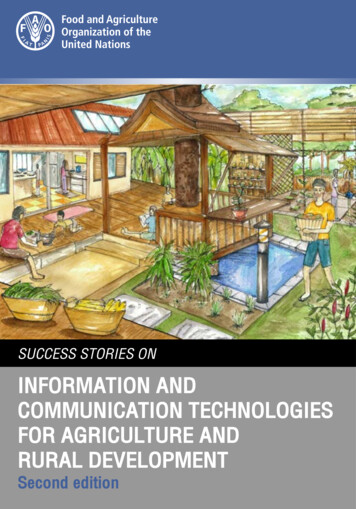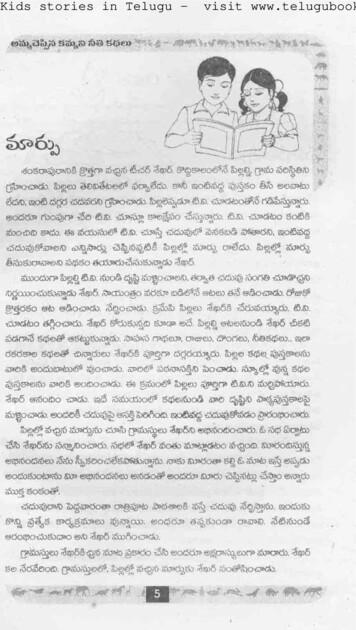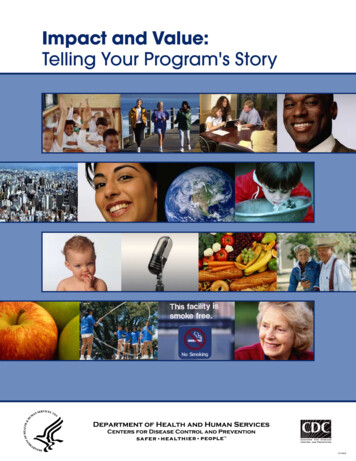
Transcription
SUCCESS STORIES ONINFORMATION ANDCOMMUNICATION TECHNOLOGIESFOR AGRICULTURE ANDRURAL DEVELOPMENTSecond edition
Success stories on information and communication technologies for agriculture and rural development
IXSuccess stories on information and communication technologies for agriculture and rural developmentSUCCESS STORIES ONINFORMATION ANDCOMMUNICATION TECHNOLOGIESFOR AGRICULTURE ANDRURAL DEVELOPMENTSecond editionEdited byGerard SylvesterRegional Office for Asia and the PacificFood and Agriculture Organization of the United NationsBangkok, 2017
Ghosh Nimai ChandraII
ms and abbreviationsIX.Introduction. 1Case Study 1: Digital Green: Leveraging social networks for agriculturalextension. 3Case Study 2: e-Krishok: Making ICT work for farmers – a 360-degreeICT-enabledsolution to empower farmers17.Case Study 3: Adapting consumer technology to combat illegal fishing inTimor-Leste. 27Case Study 4: Mobile GAP Assessment System: New technology for familyfarmsinvolved in quality assurance schemes37.Case Study 5: The revolutionary PRIDE model by mKRISHI – empoweringfarmers to live with dignity55.Case Study 6: Mobile Market Information Service: A pilot project of ICT use69for smallholder farmers in Papua New Guinea.CaseStudy 7: Nano Ganesh – a revolutionary ICT tool for farm irrigation79.
4.Mr Narshingh Lal, an orange farmer, proudly showing the orange trees he planted afterwatching the video from Digital Green.6A local video production team in the process of creating a video using local actors.9A vibrant discussion amongst the community, following a video screening in Ghana.10Improved social status – a group of empowered women farmers with Ms Pinky Devi (centre).12The e-Krishok service.20e-Krishok logo.21Farmbook’s administration panel.22Farmbook validation report.22Mr Md. Awal and his tomato farm.23Farmer consulting with the BIID team.24Mr Md. Sadir Udding Pradhan in his lychee orchard.25A type of fishing craft commonly used around Timor-Leste.27A fisher with a PLB.28One button to report IUU, one for emergencies.30Data from the PLBs can be tracked online.30Fishers learn to use the devices.31Fisheries inspectors equipped with PLBs aboard a commercial fishing vessel.34A local fisher brings home his catch.36The ‘Q’ mark on an agricultural product certified by the Department of Agriculture.38Samkha village, representative of family farms in remote areas of Thailand.39Wild fire, flash floods and drought resulting from human activity upset the natural balance.40Ms Srinuan Wongtrkul acts as a community information broker.40Before (2005, left) and now (right), Samkha reservoir and a check dam network haverejuvenated the community.41Rice camp organized by RMUTL and NECTEC in July, 2009.41Students of Samkha community as IT facilitators.44Home page of the Mobile GAP Assessment System.45CBs and internal auditors learning together for system implementation.46Workflow of the Mobile GAP Assessment System.47Screenshot of the GAP-01 form. Farm and farmer’s registration format.48Screenshot of the GAP-02 form. Farm data input form for the traceability system.48Screenshot of the GAP-03 form on Android devices. Farm.49Screenshot of the GAP-04 form on Android devices. Recommendations to improveproduction based on certification results.50Components of the system.52Ms Nari Inmapan with her quality rice products for sale; a pioneer group ofinternal auditors trained on system use.53
1.52.53.54.Conventional PRIDE framework.56The impact of PRIDE empowered with the mKRISHI technology.57Interactions among various mKRISHI components.58The CROPS framework.59CHPCL company logo.60The TCS mKRISHI team’s field training for PRIDE farmers (vermicomposting).61Capacity building flow – CHPCL.62Linkages – CHPCL.63TCS’s expansion plan.66Mobile phone screen with composed message for potato.73Map indicating the urban markets.74A farmer controlling his pump by mobile phone.80Night visits to a water pump.81Nano Ganesh flow chart.83Nano Ganesh operation sequence.85Nano Ganesh C with a mobile phone.86A local village electrician is vital for ICT implementation in irrigation.87Precise irrigation control.88Advocacy of ICT at rural exhibitions.91Analytics of water pumps possible.92Boxes1.2.3.4.5.A farmer’s story. 4A perspective from a community leader. 42A farmer who learned how to use technology with children. 45A software developer. 46System components. 51Tables1. Crop type, code units and variables.722. Steps used in creating SMS to obtain market information.733. Nano Ganesh C product details.87
Min ZawVI
VIIForewordAgriculture has undergone many transformations over thousands of years. Humanityhas moved from a society of hunter-gatherers to an agrarian community and then to onewhere agriculture is handled as an industry, yet still primarily supported at the sourceby smallholder family farms. While machines have, largely, replaced the manual plough,modern technology, or e-agriculture applications, hold out great promise as the nexttransformation in this sector.As we know, the task of producing food for more than seven billion people is not an easyone. This is further compounded by difficulties posed by climate change, competitionfor increasingly scarce resources, limited availability of arable land, disease and pestinfestations, food loss and waste among others.These challenges are immense for smallholder farmers and family farmers. There aremore than 500 million family farms in the world. They range from smallholders andmedium scale operations, to peasants, indigenous peoples, traditional communities,fisher folk, pastoralists and many other groups worldwide who rely on the land and theseas for subsistence.The growth of information and communication technologies, or ICTs, over the last decade has been phenomenal. From 2G/3G connectivity, we are now in a phase wherewe discuss sensor networks, machine-to-machine (M2M) communication, Internet ofThings (IoTs) and Big Data. These developments should be harnessed in an affordableway to benefit the majority of small holders. If a simple SMS message can alert thefarmer or fisher – indeed alert the whole community – about important information,then this is a major step in the right direction and it benefits everyone, from producersto consumers.Information and Communication Technologies can transform lives and improvelivelihoods – more so for people involved in agriculture and allied activities. ICTs canalso increase access to financial services for rural communities, helping to secure savings, find affordable insurance and tools to better manage risk. ICTs also widen thereach of local communities, including women and youth, and provide newer businessopportunities thereby enhancing livelihoods.The following pages document a collection of case studies, originally printed in 2015,and highlight some of the promising uses of ICT in the agricultural and rural domains.Going forward, FAO, together with our partners, will continue to identify and promotesustainable and scalable ICT solutions for the benefit of all.Dr Kundhavi KadiresanAssistant Director-General and Regional RepresentativeFAO Regional Office for Asia and the Pacific
VIIIA cknowledgementsThis is the second edition of this publication, previously released in 2015.Together with the countries, organizations and individuals acknowledged in the firstedition, the support and guidance of the current FAO Assistant Director-General andRegional Representative for Asia and the Pacific, Dr Kundhavi Kadiresan is kindlyacknowledged.Gerard SylvesterRegional Knowledge and Information Management OfficerFAO Regional Office for Asia and the Pacific
IXA cronymsand abbreviationsACFSAIGSAgriCommS AgriKnoB AusAIDAPIsB2BB2CBAIFBIIDBoPCBCHPCLCOCOCOCOBODCROPS CRPsCRSDAEFRFPDAG2BGAPGDPThe National Bureau of Agricultural Commodity and Food Standards,Ministry of Agriculture and CooperativesAgricultural Innovative Grant SchemeAgri Commerce SystemAgri Knowledge BaseAustralian Agency for International DevelopmentApplication programming interfaceBusiness to BusinessBusiness to CustomerBharatiya Agro Industries FoundationBangladesh Institute of ICT in DevelopmentBase of the PyramidCertification BodyChennai Horticulture Produce Producer Company LtdConnect Online Connect OfflineGhana Cocoa BoardCrop Rotation, Optimization and Planning SystemCommunity Resource PersonsCatholic Relief ServicesDevelopment AgentElectronic Farm RecordFresh Produce Development Agency (FPDA), PNGGovernment to BusinessGood Agricultural PracticeGross Domestic Product
CMMISNDFANECTECNSTDAOSPHPPLBPNGPRIDE QRRFLPRMUTLSAAOIndian Council of Agricultural ResearchInternational Crops Research Institute for the Semi-Arid-TropicsInformation and Communication Technology for DevelopmentInternational Fund for Agricultural DevelopmentInstitute of Product Quality and Standardization, Maejo University, ThailandInformation TechnologyIllegal, Unreported and UnregulatedInteractive Voice ResponseJavaScript Object NotationKnowledge ManagementKrishi Vigyan KendraMassachusetts Institute of TechnologyMaejo UniversityMassive Online Open CourseMobile Market Information Service, PNGNational Directorate of Fisheries and AquacultureNational Electronics and Computer Technology Center, ThailandNational Science and Technology Development Agency, Ministry of Scienceand Technology ThailandOperating SystemPersonal Home PagePersonal Locator BeaconPapua New GuineaThe Progressive Rural Integrated Digital EnterpriseQuick ResponseRegional Fisheries Livelihoods Programme for South and Southeast AsiaRajamangala University of Technology Lanna, ThailandSubassistant Agriculture Officers
XISearch and RescueSmall Farmers Agriculture Business ConsortiumTechnical Advisory CommitteeTATA Consultancy ServicesTamil Nadu Agricultural UniversityTraining and Visit (method)Vessel Monitoring SystemsWide Super Video Graphics ArrayWide Video Graphics ArrayWide Extended Graphics Array GAWVGAWXGA
Mosista/Shutterstock.comXII
Introduction1Success stories on information and communication technologies for agriculture and rural development Denphumi/Shutterstock.comFamily farming remains the predominant form of agriculture in Asia and the Pacific.There are more than 570 million farms in the world of which over 500 million arefamily-owned. They are responsible for at least 56 percent of agricultural production.These smallholder resource-poor farmers are confronted by many challenges – thenegative impact of climate change, increased frequency of natural disasters, loss ofbiodiversity, crude oil price hikes, rapid expansion of bioenergy development, increasingfood price volatility, inefficient supply chains and others. The information needs offarmers will only increase as they have to make more and more complex decisions onthe use of their land, selection of the agricultural commodities they plant, choice ofmarkets to sell their agricultural products and other necessary decisions that impact thelivelihoods of their families and society. Indeed, agriculture is becoming increasinglyknowledge-intensive.
2 Rauf AlamsyahSuccess stories on information and communication technologies for agriculture and rural developmentConversely, we have witnessed the development of information communicationtechnology, or ICT, as a major driver of economic growth. In addition, emerging ICTshave provided new opportunities to address the challenges faced by agriculture. Forexample, increasing use of mobile phones for information exchange, such as diseasesurveillance and pest tracking, is now common practice. Linking knowledge to innovationis also crucial to addressing the information and knowledge gaps in the agriculturesector. Therefore, ICTs can also play a very important role in bridging information gaps.FAO has been promoting the use of ICTs in agriculture and has focused on ICT innovationfor improving agricultural production and enhancing value chains. This publication is aneffort to share success stories on the use of ICTs for agriculture and rural development.A follow up to the FAO publication Information and communication technologiesfor sustainable agriculture (http://www.fao.org/docrep/019/i3557e/i3557e.pdf), thisknowledge-sharing effort helps to ensure that innovations are widely shared and a widerange of stakeholders is benefited, thereby contributing to efforts for creating a ‘worldwithout hunger’.This publication showcases a few case studies where innovative use of emergingtechnologies together with capacity development has brought about rich dividends.Digital Green’s experiences in knowledge sharing among rural communities to NanoGanesh’s innovative use of technology in switching on irrigation pumps have thepotential to contribute significantly to the livelihoods of farming communities.
3Success stories on information and communication technologies for agriculture and rural developmentCase Study 1:Digital Green: Leveraging socialnetworks for agricultural extensionRikin Gandhi 1Philosophy and strategy: Participatory video to improve existing agriculturalextension systemsOverviewDigital Green’s early roots were formed as a Microsoft Research Project in Bangalore.Founded in 2006 by Rikin Gandhi, the project was part of an effort to test different waysof using technology for social development. More specifically, the project focused ontesting the use of participatory videos as a means of agricultural extension. The approachwas substantially more effective as a means of extension than existing conventionalagricultural extension programmes.The use of video for agricultural extension was by no means a new approach and DigitalGreen was inspired by a number of different projects. These can be broadly categorizedas information technology for agricultural development, video in agricultural extensionand mediated instruction for effective training with video. Digital Green weaves togetherthe best of these three strands into a novel system that maximizes the impact ofagriculture extension workers and adds the critical element of community engagementand participation throughout the process. Based on the success of the project, DigitalGreen was formally established as an NGO in 2008, with offices in Bangalore, Karnatakain India and Berkeley, California in the USA.Background and context: Agricultural extension systems in IndiaSmall-scale farmers make up about 70 percent of India’s farming community, butexperience deep economic and social inequities in comparison to large land-holdingfarmers. Indeed, recent studies have revealed that most small-scale farmers no longerview farming as a sustainable livelihood source. Even Mr Santosh Sharma, who isregarded as a relatively well-off farmer in his village, says, “Farming is no longer adependable source of income. It was during my father’s and grandfather’s generations,but now everything is changing, from the market to the environment. Now I tell mychildren that they should study well and get jobs outside the village, because that is theonly way they can have a good life.” Mr Sharma’s story is related in Box 1.1Digital Green, India: contact@digitalgreen.org
4Success stories on information and communication technologies for agriculture and rural development Digital GreenBox 1. A farmer’s storyA farmer explains the effects of the climate on his cropsIn January, the wheat fields sown in the previous year all over Rajgarh District ofthe Indian state of Madhya Pradesh are flourishing. Their long stalks sway elegantlyin the breeze and the ears of the grain are ripening into plump seeds. However, thepicture is not as rosy as it appears to the untrained eye and the changing weatherhas wreaked great damage on the crop. Everywhere, large patches in wheat fieldshave been flattened by excessive rain and wind. The kernels of wheat are full of waterfrom dew and fog, and the seeds inside are rotting from the uncharacteristic lack ofsunshine.Despite the obvious problems caused by the weather, Mr Santosh Sharma, along-time farmer from Biaorakala village (Khilchipur block, Rajgarh District) remainspositive about his own wheat fields. When prompted, he explained that this year hehas chosen to plant a different variety of wheat. This newer strain, called Variety322, is more resistant to climate change in addition to giving a higher yield of grain.Each seed produces a greater number of individual stalks – about ten per seed asopposed to about six per seed in the older varieties and each stalk is thicker than earliervarieties. Variety 322 is better able to withstand the wind, rain and excessivemoisture that the region is facing this season. While Mr Santosh still anticipates alower yield than if the weather was more amenable, he is grateful that his crops havemanaged to withstand the climatic challenges to some degree.Santosh is one of the few farmers from his village who has managed to cope withthe weather this year, and attributes this to the videos on wheat cultivation thathe watched. These short eight-to-ten minute documentaries, developed by DigitalGreen along with its partners in the local NGO ACCESS, as well as the villagecommunity, demonstrate best agricultural practices for farmers. The videos are
5Success stories on information and communication technologies for agriculture and rural developmentmade in the local language by the community, for the community, using membersfrom the community as actors. Santosh has not only seen most of the videos developed in his district, but also featured in some of them. He has adopted several of thepractices, and is a strong advocate of the video-based learning process amongst hispeers.Explaining what he finds successful about the approach, Santosh says, “Not only dovideos allow farmers to see a visual demonstration of the entire process, they alsofeature practices that can easily be tested. For example, I planted Variety 322 on asmall part of my land last year. When I saw that it gave me a bigger yield than theother variety, I decided to plant more of it this year. I am lucky, because it is alsostronger and better at surviving in this bad weather.” Furthermore, he adds, “Farmersare always keen to learn new and better ways of growing their crops. The videosare helpful because the entire process is visually demonstrated and explained in ourown language by farmers from our own community. All this makes it easier for usto understand.”Public investment in agriculture has also fallen over the past few decades. Whilesome of this decrease has been offset by the private sector, these investments tend toconcentrate on larger, more mechanized farms. The largely traditional approach toagricultural extension in countries like India has further isolated and increased thevulnerability of small-scale farmers. During India’s green revolution of the 1970s and1980s, the most commonly used method of extension was the Training and Visit method(T&V method), which followed a top-down approach to information dissemination. Thepurpose of the T&V approach is to encourage farmers to increase production of specifiedcrops. However, planning is controlled centrally and field personnel tend to bedependent on central resources; there is a rigid pattern of visits to farmers and in-servicetraining of field staff. While the approach provides scientific and technical support, itlacks genuine two-way communication and the flexibility required to make it responsive to the local situation. The T&V approach gave way to extension programmes thathave focused instead on developing more participatory, decentralized, demand-drivenservices. These approaches are also better tailored to addressing the diversity of culture,language, geography and other socio-economic and environmental factors, tailoringinformation to the local context.Despite several efforts to reach small-scale farmers, however, India’s current extensionsystem often fails to effectively communicate with them. This is largely due to issuessuch as generic, top-down content to which the farmers cannot relate. While the contentmay be scientifically accurate, it may not be presented in a way that the farmers can easilygrasp, either due to language barriers or because it is presented in brief or abstractly. MrNarsingh Lal, another progressive farmer from Santosh’s village says, “Earlier, people
6Success stories on information and communication technologies for agriculture and rural development Digital Greenfrom NGOs or the government used to come and visit us and tell us about good farmingpractices. While it was helpful, it was sometimes difficult to understand exactly what theymeant, because they were explaining everything verbally. The videos are better, becausewe can see the entire process on the field, which makes it easier to understand and alsoremember all the information.” Figure 1 shows the orange trees planted by Mr NarshinghLal after watching a Digital Green video.Figure 1. Mr Narshingh Lal, an orange farmer, proudly showing the orange trees heplanted after watching the video from Digital GreenEven in cases where field demonstrations are part of the extension system, restrictionsof resources and personnel mean that the demonstrations take place at wide intervalswith little or no interaction with farmers in between. The lack of a local facilitator orresource person who can assist farmers in implementation often means that theseextension efforts do not result in actual adoption.Digital Green has demonstrated that a participatory process of engagement combinedwith simple technology solutions can enable small-scale farming communities toproduce and share information on best practices for improved productivity andsustainable livelihoods. Initial pilot studies not only indicated a higher uptake ofpractices through the video-based approach, but also revealed that the Digital Greenmodel was more cost-effective than classical systems of agricultural extension. Gandhiet al. (2009) state that the Digital Green approach was at least ten times more efficientand seven times more likely to encourage farmers to adopt new practices compared toconventional agricultural extension systems.
7Success stories on information and communication technologies for agriculture and rural developmentThe Digital Green approach: Technology, partnerships and communityengagementThe Digital Green approach is essentially a technology-enabled means of behaviourchange communication, which is cost-effective, scalable and brings together researchers,development
Success stories on information and communication technologies for agriculture and rural development Family farmingremains the predominant form of agriculture in Asiaand the Pacific. There are more than 570 million farms in the world of which over 500 million are











